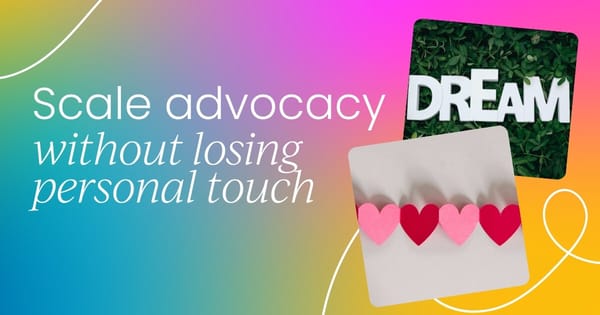Advocacy and its associated programs are the lifeblood of customer marketing responsibilities. Whether it’s customer experience, engagement, loyalty, or retention, all of it funnels into the end goal - advocacy.
While this customer journey is easy to follow with smaller customer segments, the true challenge comes when companies experience a boon in growth and must work to maintain efficiency, performance, and personalization with the customer lifecycle of their business.
So, how can customer marketers set themselves up for success when it comes to scaling advocacy for larger and larger audiences?
In this article, we’re covering:
- Why scaling advocacy programs matters
- Key challenges in scaling advocacy
- Strategies to scale advocacy programs for high personalization
Let’s get started.
Why scaling advocacy programs matters
Scaling your advocacy program is like upgrading from a cozy dinner party to a full-blown festival. When it’s small, you can chat with everyone, remember their favorite drink, and swap stories. And while it’s true that more voices equals more impact, how do you keep that personal touch when your audience grows?
When you grow your advocacy efforts (the right way), you’re unlocking some serious perks like:
- Increased brand reach: More advocates = more conversations about your brand in more places.
- Boosted credibility: Peer recommendations are marketing gold—people trust real stories more than ads.
- Community magic: Expanding your advocacy circle builds a supportive, thriving brand community.
- Diverse voices: More advocates mean more stories, perspectives, and use cases showcasing your brand's impact.
The challenge? Bigger isn’t always better if you lose the human touch. As your audience grows, you risk turning once personal and specific interactions with each customer into a slog of robotic interactions.
Modern customers expect brands to know them. Personalization isn’t just a nice touch; it’s a necessity. People want experiences that feel tailor-made, whether they’re buying shoes or sharing their story as a brand advocate.
Personalization drives:
- Stronger Loyalty: People stay engaged when they feel valued.
- Deeper Connections: Tailored experiences spark emotional bonds.
- Long-Term Engagement: Happy advocates stick around when treated like individuals.

So what are the most common missteps when it comes to this kind of scaling?
Key challenges in scaling advocacy while retaining personal touch
When you’re looking to make advocacy work on the big scale, there’s a lot to keep track of, and you won’t get it right the first time you do it. You certainly won’t get it perfect because every customer community is different.
To make the process as smooth as possible, here are the three biggest errors scaling advocacy can come into contact with:
Loss of direct one-on-one connections
When your advocate base grows, those personal “Hey, how’s it going?” moments can start to slip. The bigger the crowd, the harder it is to keep those close, genuine connections where advocates feel like VIPs, not just names on a list.
Difficulty in managing large data sets and personal preferences
Scaling means lots of data—preferences, interactions, engagement patterns. Staying on top of who prefers emails vs. DMs or which advocates love sharing testimonials can quickly become overwhelming without the right tools.
Over-automation leads to impersonal experiences
Automation is great for scaling—but too much can make your outreach feel robotic. While it’s tempting to streamline everything when scaling, too much efficiency can really dull the human touch.
Personalized touches often get lost when messages sound generic. The challenge is finding the sweet spot where automation boosts efficiency without losing authenticity.
Strategies to scale advocacy programs effectively
Now the bit you’ve been waiting for - the tips to make your scaling journey an assured success. To begin…
Segmentation and audience grouping
Think of segmentation like planning playlists for different party vibes—every group deserves the right tunes (or, in this case, messages). Here's how to make it work:
Break audiences into smaller, manageable segments based on factors like advocacy activity, interests, or engagement level. Think: your content creators, social sharers, event champions, and review rockstars.
Tailor messaging for each group and send exclusive content to your creators, offer VIP event invites to your event champions, or share testimonial opportunities with your storytellers. When messages match their passions, advocates feel valued—and a valued advocate is a louder advocate.
Personalization through automation tools
Leverage CRM and marketing automation tools with personalization features. Your CRM and marketing tools as your backstage pass to knowing everything about your advocates—favorite campaigns, past contributions, and even milestones they've hit.
Platforms like HubSpot, Salesforce, or Marketo help you automate outreach while still personalizing details like names, interests, and advocacy history.
Dynamic content and customized messaging let you create a single campaign that adapts based on advocate behavior, preferences, or segments. Using this means emails can offer specific opportunities for specific kinds of advocates with an easy lift on your end.
Empowering brand advocates with resources
Your brand advocates are already rockstars—so why not give them the tools to shine even brighter? Empowering your champions with the right resources makes it easier for them to spread the word while keeping their unique voice. Here's how:
1. Provide training & templates for personalized outreach
- Share ready-to-go templates for social posts, emails, and testimonials that still leave room for a personal twist.
- Offer short workshops or webinars on advocacy best practices—like how to craft authentic LinkedIn posts or share event experiences.
- Create an easy-access resource hub filled with brand guidelines, image assets, and messaging examples for inspiration.
2. Encourage personal storytelling & user-generated content
- Prompt advocates to share their success stories, not just praise for your brand.
- Feature user-generated content in newsletters, social feeds, and on your website.
Humanizing mass communications
Using personalized video messages can transform generic outreach into something memorable. Sending a quick thank-you video with the advocate’s name mentioned—bonus points if it’s from a team member they know—feels special and genuine.
Recording personalized invites for advocacy events or campaigns instead of a standard email blast makes people feel valued, while tools like Vidyard or Loom help you create quick, heartfelt videos that stand out in a crowded inbox.
Incorporating customer stories and testimonials takes it even further by letting your advocates’ voices shine. Sharing real stories in newsletters, social media, and nurture campaigns adds authenticity while spotlighting the individuals behind the praise.
Leveraging data analytics for personalization at scale
Using data to identify customer preferences and behaviors
Track behaviors like event attendance, content sharing habits, and product usage to personalize outreach. When you know what makes each advocate tick, you can send messages that actually resonate.
Balancing data-driven insights with authentic engagement.
Avoid sounding robotic by blending insights with authentic, conversational messaging. Think of data as the guide—not the whole story—so your advocates feel seen, not just analyzed.
Tools and platforms for effective data management.
Use tools like HubSpot, Salesforce, or Marketo to manage data without overwhelm. These platforms help centralize insights, segment advocates, and automate personalized messaging at scale.
Conclusion
Balancing scalability with personalization in your advocacy programs isn’t an impossible task.
By segmenting your audience, personalizing through automation tools, empowering advocates with resources, humanizing mass communications, and leveraging data effectively, you can expand your reach without losing the personal spark that makes advocacy powerful.
Remember, advocacy is all about relationships. Prioritize making your advocates feel valued, heard, and connected to your brand’s story. When you lead with authenticity, engagement naturally follows.
Want to level up your advocacy skills even more? Check out the Customer Marketing Alliance's Micro-Course on Customer Advocacy, hosted by Kevin Lau. Learn expert strategies to build and scale impactful advocacy programs that keep customers at the heart of your growth!


 6 min read
6 min read
 Follow us on LinkedIn
Follow us on LinkedIn




